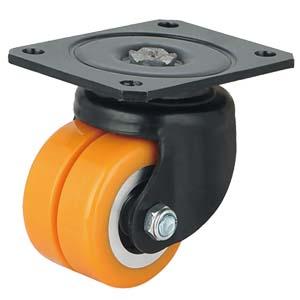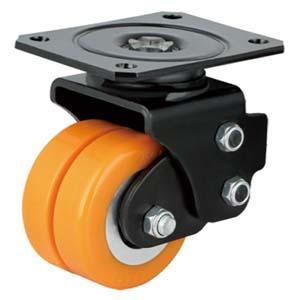Different between agv casters and common casters
22 Jan / 2024AGV casters, or automated guided vehicle casters, are specialized caster wheels designed for use in automated guided vehicles (AGVs). These vehicles are mobile robots that navigate through predetermined routes to transport goods or perform tasks within a facility. In contrast, common casters refer to standard caster wheels commonly used in various applications, such as furniture, carts, and industrial equipment. In this article, we will explore the differences between AGV casters and common casters in more detail.
Design and Construction:
One major difference between AGV casters and common casters lies in their design and construction. AGV casters are specifically engineered to withstand the demanding requirements of AGV systems. They are typically smaller and more compact in size, allowing them to fit into tight spaces and maneuver efficiently in narrow aisles. The compact design also ensures minimal interference with the overall dimensions of the AGV, maximizing its payload capacity.
Common casters, on the other hand, come in various sizes and designs to cater to different applications. They are often larger and more robust compared to AGV casters, providing stability and load-bearing capabilities necessary for heavy-duty tasks. Common casters are commonly made from materials like steel, rubber, or polyurethane, depending on the specific application requirements.
Navigation and Control:
One of the key differentiating factors between AGV casters and common casters is their navigation and control capabilities. AGV casters are equipped with advanced sensors, such as laser scanners or vision systems, and integrated control algorithms that enable precise and autonomous navigation. These technologies allow AGVs to follow predetermined paths, avoid obstacles, and perform complex maneuvers safely. The precise movement of AGV casters is crucial to ensure the efficient and reliable operation of AGV systems in industrial environments.
In contrast, common casters lack the sophisticated navigation and control features found in AGV casters. They rely on manual steering or basic swivel mechanisms that offer limited maneuverability. While common casters can provide mobility in various applications, they do not possess the autonomous navigation capabilities necessary for AGV systems.
Load Capacity and Performance:
AGV casters are designed to handle specific load capacities and performance requirements associated with AGV applications. Due to their smaller size and compact design, AGV casters typically have lower load capacities compared to common casters. However, they are engineered to operate within precise weight limits to ensure safe and efficient operation of AGV systems. AGV casters also prioritize speed and agility to maximize the productivity and throughput of AGV operations.
Common casters, on the other hand, are available in a wide range of load capacities, from light-duty to heavy-duty options. They are built to handle various loads and can be selected based on the specific application requirements. Common casters may sacrifice some speed and agility for increased load capacity and stability.
Special Features and Customization:
AGV casters often come with additional features and customization options to enhance their performance in AGV applications. For example, some AGV casters may incorporate swivel locks or brakes to provide added control and stability during loading and unloading operations. Others may incorporate shock-absorbing systems to minimize vibration and ensure the safe transportation of delicate or fragile goods. These features are specifically tailored to address the unique challenges faced by AGVs in industrial environments.
Common casters, on the other hand, have a wide range of additional features and customization options available depending on the specific application. These may include different wheel materials, brake mechanisms, swivel locks, or specialized mounting configurations. Common casters offer flexibility to cater to various requirements across industries.
Cost and Availability:
AGV casters are generally more specialized and, therefore, can be more expensive compared to common casters. The advanced technology and specific design considerations involved in AGV caster production contribute to the higher cost. Additionally, AGV casters may have limited availability in the market due to their niche application.
Common casters, being widely used across different industries and applications, are generally more readily available and cost-effective. They benefit from economies of scale, making them a cost-efficient choice for applications that do not require the advanced capabilities of AGV casters.
In conclusion, AGV casters and common casters differ significantly in terms of design, navigation and control, load capacity, special features, and cost. AGV casters are tailored for use in automated guided vehicle systems, offering precise navigation, compact size, and specialized features to optimize performance. On the other hand, common casters serve a broader range of applications and come in various sizes and designs to accommodate different load capacities. Understanding these differences is crucial when selecting the appropriate caster for specific applications and ensuring effective material handling and transport operations.

